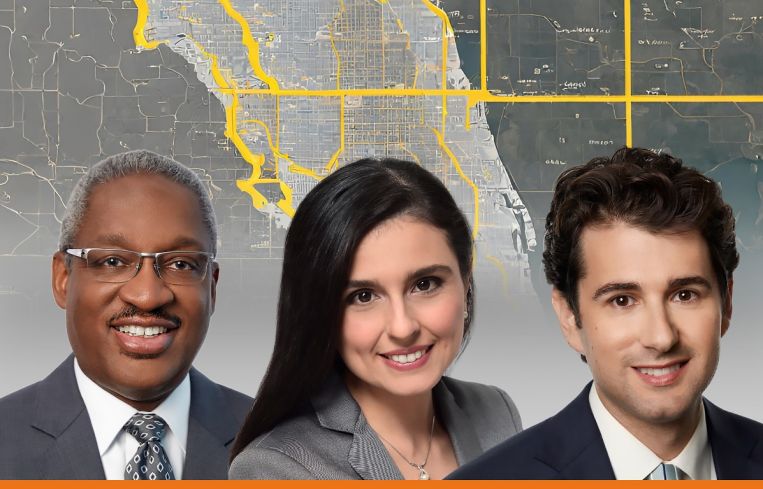Presented By: Bilzin Sumberg
Mastering the ABCs of P3s in Florida
Authors: Al Dotson, Eric Singer, Diana Mendez
By Bilzin Sumberg October 23, 2023 8:00 am
reprints
One of the most significant transit projects in Florida history reached a new milestone last month when the Brightline rail system expanded its service from South Florida to Orlando. Brightline marks the first privately developed passenger train to be built in the U.S. in more than a century. Plans are already underway to expand the train’s route in Florida to Tampa, and to bring the service to other markets across the country, including Los Angeles and Las Vegas.
In Florida, the Brightline stands as a high-profile example of how the public and private sectors are working together to improve the state’s infrastructure amid historic population and economic growth.

More than 300,000 people moved to the Sunshine State in 2022, making it the most popular destination among domestic transplants. Central to Florida’s appeal has been the state’s business-friendly policies, with elected leaders vowing to maintain its status among nine states without an income tax.
These dynamics – meeting heightened demand for public services among a fast-growing population without putting a strain on taxpayers – have opened the door to public-private partnerships which unite municipalities and state agencies with developers and investors to bring about improvements to public sector assets and infrastructure.
Known as P3s, these public-private partnerships are agreements between a government and a private entity that accepts the responsibility of providing a public service or developing a public facility. P3s create private sector revenue streams in exchange for delivering public services or facilities in an efficient manner, with the goals of both improving quality of service and offsetting the cost burden that would otherwise be placed on taxpayers when governments undertake infrastructure or public realm improvements.
“With Florida’s population expected to maintain its growth trajectory in the foreseeable future, Florida’s state-run agencies and municipalities will continue looking to P3s as a viable method for ushering in new domestic and international investment,” explained Bilzin Sumberg Managing Partner Al Dotson, Jr., who leads the firm’s P3 practice.
The Brightline rail system is just one example of how the public and private sectors are working together to meet market demand and improve infrastructure. P3s are taking on many forms in Florida, including the development and enhancement of airport terminals, marinas, sports and entertainment venues, convention centers, health care and research facilities, colleges and universities, water and sewer systems, and roads and bridges.
In Miami-Dade County, Bilzin Sumberg played a key role in bringing to life Liberty Square Rising, the county’s first-ever P3 public housing development. This master-planned, 55-acre community established a new model for the design, construction, financing, operation, and maintenance of large-scale public housing developments that has since been replicated both in South Florida and throughout the country.
“Developers and contractors may have a misperception that public-private partnerships are only used for toll roads and similar large-scale horizontal infrastructure projects, but P3s are more and more frequently being used to deliver government buildings or joint-use public and private buildings that are within the wheelhouse of many developers,” said Bilzin Sumberg partner Eric Singer. “In fact, P3s have the potential to address a multitude of public-sector challenges, such as the mounting need for new housing options, advancements in education, or accessibility improvements.”
P3s typically manifest in one of two ways: through unsolicited proposals brought forward by a private development entity, or through a request for proposals (RFP) issued by a municipality or government agency. The process can vary by county. While elected officials often identify specific needs which may be addressed by P3s, there are typically departments that oversee procurement, often in consultation with outside experts that specialize in P3s or the specific service or facility being developed.
For example, Bilzin Sumberg recently represented a partnership between a real estate developer and a nonprofit institution that submitted an unsolicited proposal and secured a contract award for the privately funded redevelopment of a mass transit station. The project will include new station infrastructure, a public parking garage, and residential units set aside for transit operators, active military and veterans, and young adults aging out of the foster care system. This project, which will be at the Palmetto Metrorail Station in Miami-Dade County, accomplishes several public policy objectives.
When the City of Tampa issued an RFP in connection with an 18-acre property primed for redevelopment, Related Urban Development Group partnered with the Tampa Housing Authority (THA) to pursue the project. The team combined Related’s development expertise with the THA’s hyperlocal market knowledge. Related and the THA won the RFP, paving the way for a $250 million mixed-use development that includes affordable housing, workforce housing, and commercial space. The project also comprises numerous community benefits and public infrastructure enhancements, including cultural amenities, parks, and a workforce training center. Bilzin Sumberg helped the team navigate the RFP process, including defending against a bid protest and negotiating the applicable agreements.
“Successful public private partnerships require a certain level of collaboration among all parties,” added Bilzin Sumberg Partner Diana Mendez. “When pursuing a P3, it’s critical that developers take time to understand the local landscape and engage a team of consultants who have a keen understanding of the legal, political and community dynamics at play.”
Bilzin Sumberg has guided teams through several multibillion-dollar P3s in Florida. The Firm’s work spans all phases of the development cycle, including the creation of joint ventures, procurement, finalizing government contracts, project finance, and construction. For more information on opportunities within Florida’s P3 landscape, visit our Government Procurement and P3 Insights Blog.


